calsfoundation@cals.org
Onia (Stone County)
Onia (pronounced Ownie) is located on Highway 263 three and a half miles north of Timbo (Stone County) near Roasting Ear Creek. The creek—popular for swimming, fishing, and baptisms—reportedly received its name when ears of corn were washed downstream during a flood. The two main landmarks of Onia are the Bethany Baptist Church and the post office in the center of the community. At one time, the area was part of the large community of Locust Grove, which was located in Searcy County before Stone County was created on April 17, 1873. What is today Onia was often referred to by locals as Lower Clark, with Upper Clark being in the Thola area of Searcy County.
Near the old Roasting Ear Church and School is Mill Creek, the site of the Rorie grist mill and sawmill. Due to Union intelligence that weapons and contraband were hidden in Rorie Cave on the bluff, the mills were burned by Union troops during the Civil War in January 1864. Despite being civilians, father and son Absalom and Hezekiah Rorie, along with other family members, were killed during the raid. Rorie Cave is now sealed off.
The Balentine family from Wayne County, Tennessee, was among the first to settle what would become Onia. Benjamin Simmon (Ben) Balentine and his wife, Melissa Elzura Erdine “Malsa” Sport Balentine, arrived in what was then called Lower Clark in 1873. Their son, known as Elder John James Balentine, was a popular Baptist minister of Onia. Balentine and his wife, Malinda Louise Branscum Balentine, are buried at Pordue Cemetery in Onia. (The Branscum family also arrived in Locust Grove in 1873.) Solomon Brewer from Butler Creek in Wayne County, Tennessee, arrived with the Balentine and Branscum families and married Sarah Elizabeth Branscum.
When the community received a post office in 1908, the new postmaster, James Almon Branscum, who was a Baptist preacher and state representative, could not think of an acceptable name. It was decided to name the post office after the winner of a local beauty contest. The three finalists were Edna Bertha Branscum (related to the postmaster); Malinda Iona Balentine, commonly known as Ona or Onie (daughter of Elder John James Balentine and Malinda Louise Branscum); and Lillie Sutterfield. Ona won the contest, but when a postal service bureaucrat looked at the name, he thought it had been misspelled and changed it to Onia. The following year, Ona Balentine married D. E. Fox. The first post office was connected to a general store run by Eli McCook, Bud Moore, and others.
At one time, Onia had two stores: the post office store and the Phillips Store. There was also the Pony Peak Ranch for boys between Onia and Timbo on Pony Peak Road; known locally as the Dude Ranch, it was run by Alan Nixon and overseen by Graden Richardson. The Richardson Saw Mill was located on Roasting Ear Creek at Onia in the early 1900s.
Most of the students at Onia attended school at Bethany Baptist Church and school, until the church/school building was destroyed by fire about 1925. Land was donated by Willis and Ella Moore for a one-room school called Lower Clark No. 12. In 1949, a new district was formed called Stone County School District No. 1. Onia students began going to Timbo School in 1950. Timbo had its own elementary and high school until 2004, when it was consolidated with the Mountain View School District.
In the twenty-first century, two of the early school buildings near Onia are still standing: the Bluff Springs school building built in 1900 and the Roasting Ear school building (a vernacular Greek Revival structure) built in 1918. Both were placed on the National Register of Historic Places in 1985. The buildings were used for a time as churches. Since the mid-1980s, they have been used for community gatherings.
The Caston stone quarry is located on Fairview Road in Onia. Stones mined on site include patio rock, field stone, creek rock, tumbled stone, and boulders. Caston Stone is owned by the father-and-son team of R. C. and Lewis Caston. Caston Stone was started in 1995 and sells stone to companies around the country. The Caston family farm also has cattle and grows blackberries, blueberries, and peaches.
Private First Class Hubert Brewer of Onia was one of many from Stone County to serve during World War II. Brewer, who became a prisoner of war, was forced to participate in the Bataan Death March. He was killed in the sinking of the Arisan Maru. His name is listed on the Tables of the Missing in Manila, Philippines.
Thomas Lewis Lavy, a farmer charged with terrorism, attracted worldwide attention to Onia in 1995 despite having only moved to Onia from Missouri via Alaska in the autumn of 1992. In April 1993, he attempted to cross the American border into Canada from Alaska with several firearms, ricin poison, and $89,000 in cash. Two years later, he was arrested by the Federal Bureau of Investigation (FBI) on terrorism charges. A media blitz ensued, though Lavy’s intentions were never made clear. Four days after his arrest on December 20, 1995, he hanged himself in his jail cell in Little Rock (Pulaski County). The episode is still controversial.
Most Onia residents shop in nearby Timbo or at the county seat of Mountain View (Stone County). Farming and livestock still dominate the economy, with many holding jobs in Mountain View or elsewhere.
For additional information:
Deane, Ernie. “In the Hills, a ‘Dude Ranch’ for Children.” Arkansas Gazette, August 1, 1958, p. 1B.
“Onia, A History.” Heritage of Stone County 37 (2013): 1–32.
Kenneth Rorie
Van Buren, Arkansas
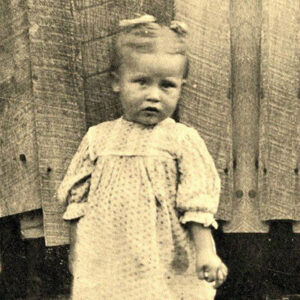 Ona (Onie) Balentine
Ona (Onie) Balentine 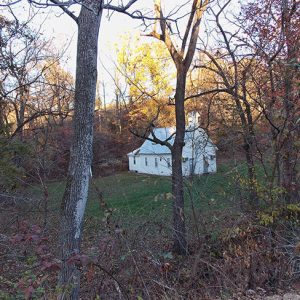 Bluff Springs Church and School
Bluff Springs Church and School 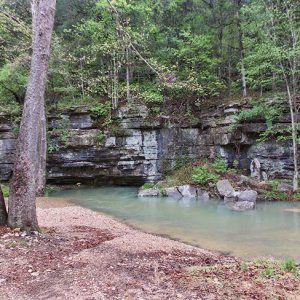 Mill Creek
Mill Creek 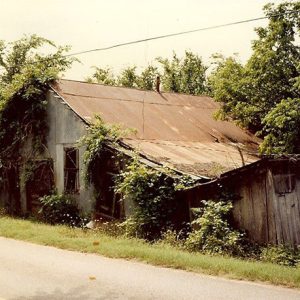 Phillips Store
Phillips Store 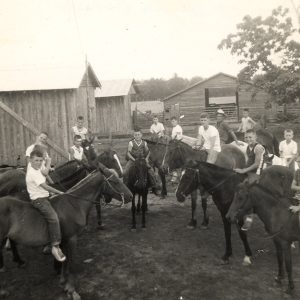 Pony Peak Ranch
Pony Peak Ranch 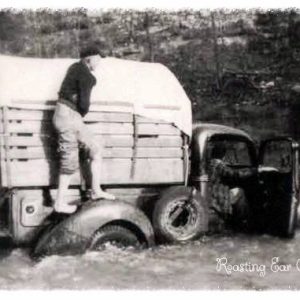 Roasting Ear Creek
Roasting Ear Creek 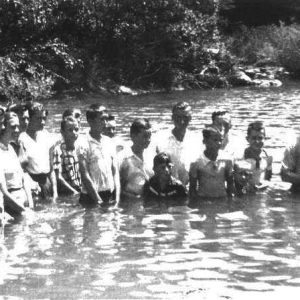 Roasting Ear Creek Baptism
Roasting Ear Creek Baptism  Roasting Ear School
Roasting Ear School 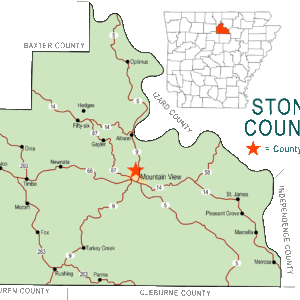 Stone County Map
Stone County Map 




Comments
No comments on this entry yet.